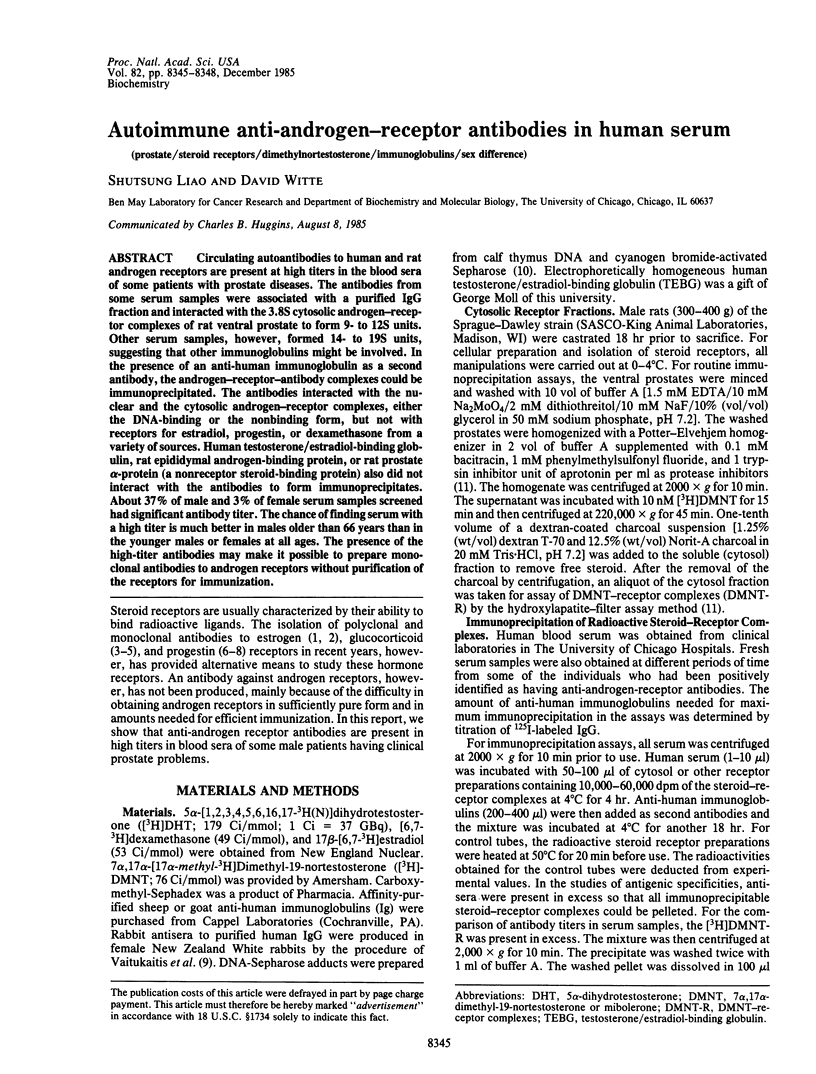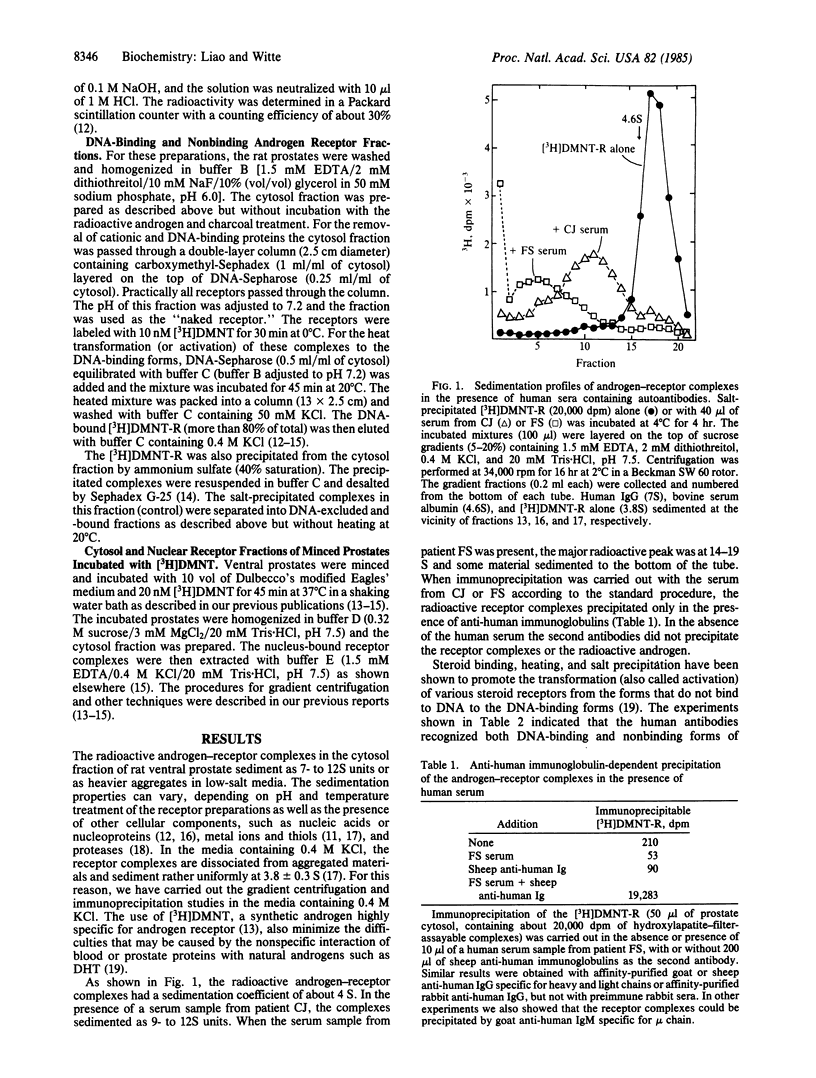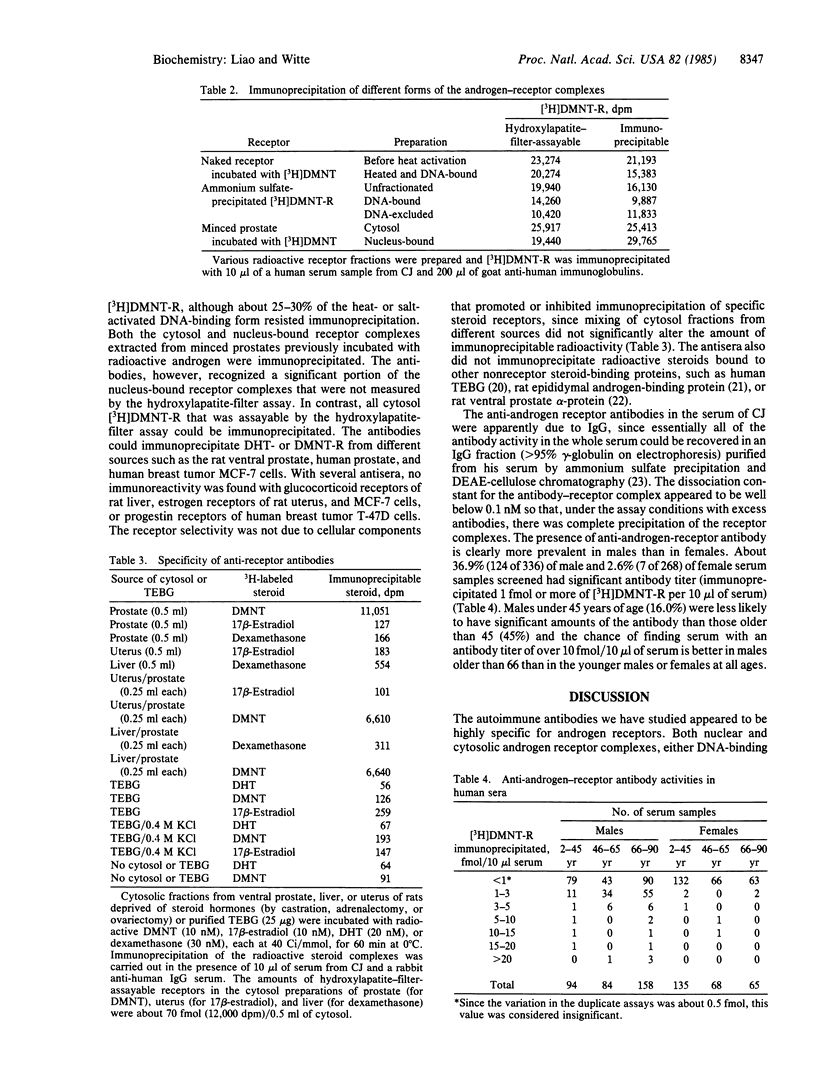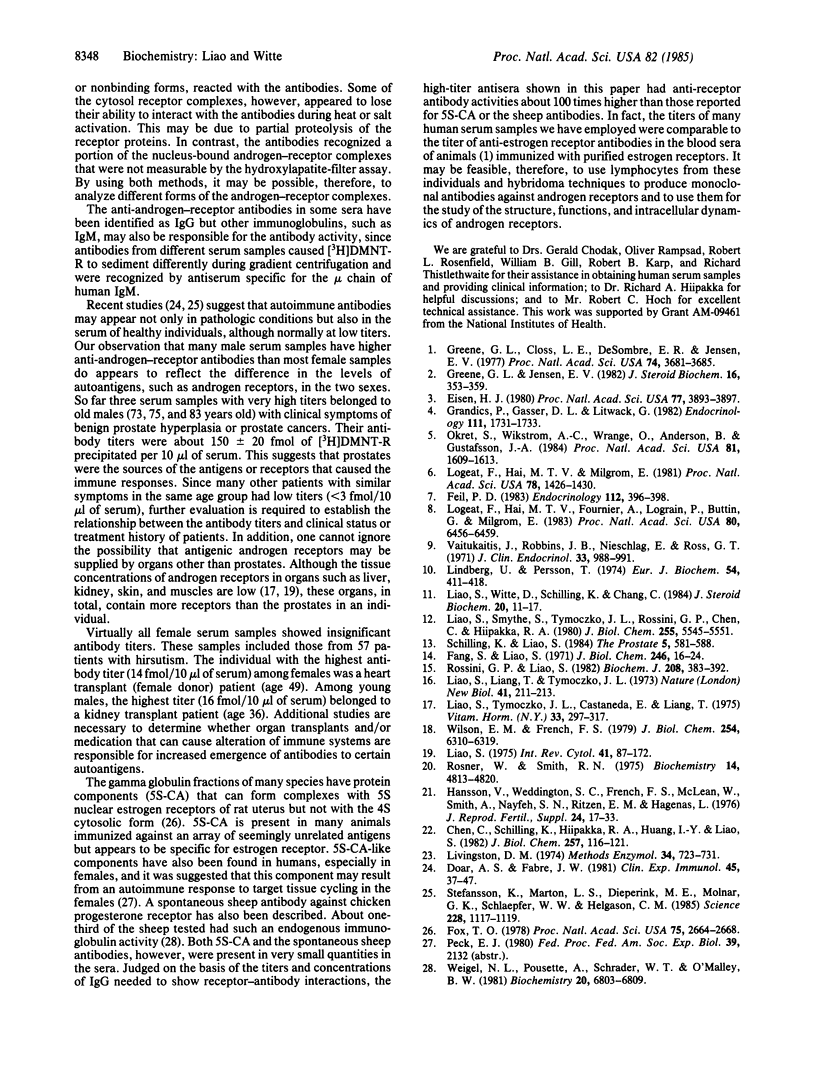Abstract
Circulating autoantibodies to human and rat androgen receptors are present at high titers in the blood sera of some patients with prostate diseases. The antibodies from some serum samples were associated with a purified IgG fraction and interacted with the 3.8S cytosolic androgen-receptor complexes of rat ventral prostate to form 9- to 12S units. Other serum samples, however, formed 14- to 19S units, suggesting that other immunoglobulins might be involved. In the presence of an anti-human immunoglobulin as a second antibody, the androgen-receptor-antibody complexes could be immunoprecipitated. The antibodies interacted with the nuclear and the cytosolic androgen-receptor complexes, either the DNA-binding or the nonbinding form, but not with receptors for estradiol, progestin, or dexamethasone from a variety of sources. Human testosterone/estradiol-binding globulin, rat epididymal androgen-binding protein, or rat prostate alpha-protein (a nonreceptor steroid-binding protein) also did not interact with the antibodies to form immunoprecipitates. About 37% of male and 3% of female serum samples screened had significant antibody titer. The chance of finding serum with a high titer is much better in males older than 66 years than in the younger males or females at all ages. The presence of the high-titer antibodies may make it possible to prepare monoclonal antibodies to androgen receptors without purification of the receptors for immunization.
Full text
PDF



Selected References
These references are in PubMed. This may not be the complete list of references from this article.
- Chen C., Schilling K., Hiipakka R. A., Huang I. Y., Liao S. Prostate alpha-protein. Isolation and characterization of the polypeptide components and cholesterol binding. J Biol Chem. 1982 Jan 10;257(1):116–121. [PubMed] [Google Scholar]
- Daar A. S., Fabre J. W. Organ-specific IgM autoantibodies to liver, heart and brain in man: generalized occurrence and possible functional significance in normal individuals, and studies in patients with multiple sclerosis. Clin Exp Immunol. 1981 Jul;45(1):37–47. [PMC free article] [PubMed] [Google Scholar]
- Eisen H. J. An antiserum to the rat liver glucocorticoid receptor. Proc Natl Acad Sci U S A. 1980 Jul;77(7):3893–3897. doi: 10.1073/pnas.77.7.3893. [DOI] [PMC free article] [PubMed] [Google Scholar]
- Fang S., Liao S. Androgen receptors. Steroid- and tissue-specific retention of a 17 beta-hydroxy-5 alpha-androstan-3-one-protein complex by the cell nuclei of ventral prostate. J Biol Chem. 1971 Jan 10;246(1):16–24. [PubMed] [Google Scholar]
- Feil P. D. Characterization of guinea pig anti-progestin receptor antiserum. Endocrinology. 1983 Jan;112(1):396–398. doi: 10.1210/endo-112-1-396. [DOI] [PubMed] [Google Scholar]
- Fox T. O. Selective complexing of the "nuclear" 5S estradiol receptor by a serum component, 5S-CA. Proc Natl Acad Sci U S A. 1978 Jun;75(6):2664–2668. doi: 10.1073/pnas.75.6.2664. [DOI] [PMC free article] [PubMed] [Google Scholar]
- Grandics P., Gasser D. L., Litwack G. Monoclonal antibodies to the glucocorticoid receptor. Endocrinology. 1982 Nov;111(5):1731–1733. doi: 10.1210/endo-111-5-1731. [DOI] [PubMed] [Google Scholar]
- Greene G. L., Closs L. E., Fleming H., DeSombre E. R., Jensen E. V. Antibodies to estrogen receptor: immunochemical similarity of estrophilin from various mammalian species. Proc Natl Acad Sci U S A. 1977 Sep;74(9):3681–3685. doi: 10.1073/pnas.74.9.3681. [DOI] [PMC free article] [PubMed] [Google Scholar]
- Greene G. L., Jensen E. V. Monoclonal antibodies as probes for estrogen receptor detection and characterization. J Steroid Biochem. 1982 Mar;16(3):353–359. doi: 10.1016/0022-4731(82)90045-0. [DOI] [PubMed] [Google Scholar]
- Hansson V., Weddington S. C., French F. S., McLean W., Smith A., Nayfeh S. N., Ritzén E. M., Hagenäs L. Secretion and role of androgen-binding proteins in the testis and epididymis. J Reprod Fertil Suppl. 1976 Sep;(24 Suppl):17–33. [PubMed] [Google Scholar]
- Liao S. Cellular receptors and mechanisms of action of steroid hormones. Int Rev Cytol. 1975;41:87–172. doi: 10.1016/s0074-7696(08)60967-5. [DOI] [PubMed] [Google Scholar]
- Liao S., Liang T., Tymoczko J. L. Ribonucleoprotein binding of steroid-"receptor" complexes. Nat New Biol. 1973 Feb 14;241(111):211–213. doi: 10.1038/newbio241211a0. [DOI] [PubMed] [Google Scholar]
- Liao S., Tymoczko J. L., Castañeda E., Liang T. Androgen receptors and androgen-dependent initiation of protein synthesis in the prostate. Vitam Horm. 1975;33:297–317. doi: 10.1016/s0083-6729(08)60962-0. [DOI] [PubMed] [Google Scholar]
- Liao S., Witte D., Schilling K., Chang C. The use of a hydroxylapatite-filter steroid receptor assay method in the study of the modulation of androgen receptor interaction. J Steroid Biochem. 1984 Jan;20(1):11–17. doi: 10.1016/0022-4731(84)90182-1. [DOI] [PubMed] [Google Scholar]
- Lino S., Smythe S., Tymoczko J. L., Rossini G. P., Chen C., Hiipakka R. A. RNA-dependent release of androgen and other steroidreceptor complexes from DNA. J Biol Chem. 1980 Jun 25;255(12):5545–5551. [PubMed] [Google Scholar]
- Livingston D. M. Immunoaffinity chromatography of proteins. Methods Enzymol. 1974;34:723–731. doi: 10.1016/s0076-6879(74)34094-3. [DOI] [PubMed] [Google Scholar]
- Logeat F., Hai M. T., Milgrom E. Antibodies to rabbit progesterone receptor: crossreaction with human receptor. Proc Natl Acad Sci U S A. 1981 Mar;78(3):1426–1430. doi: 10.1073/pnas.78.3.1426. [DOI] [PMC free article] [PubMed] [Google Scholar]
- Logeat F., Vu Hai M. T., Fournier A., Legrain P., Buttin G., Milgrom E. Monoclonal antibodies to rabbit progesterone receptor: crossreaction with other mammalian progesterone receptors. Proc Natl Acad Sci U S A. 1983 Nov;80(21):6456–6459. doi: 10.1073/pnas.80.21.6456. [DOI] [PMC free article] [PubMed] [Google Scholar]
- Okret S., Wikström A. C., Wrange O., Andersson B., Gustafsson J. A. Monoclonal antibodies against the rat liver glucocorticoid receptor. Proc Natl Acad Sci U S A. 1984 Mar;81(6):1609–1613. doi: 10.1073/pnas.81.6.1609. [DOI] [PMC free article] [PubMed] [Google Scholar]
- Rosner W., Smith R. N. Isolation and characterization of the testosterone-estradiol-binding globulin from human plasma. Use of a novel affinity column. Biochemistry. 1975 Nov 4;14(22):4813–4820. doi: 10.1021/bi00693a006. [DOI] [PubMed] [Google Scholar]
- Rossini G. P., Liao S. Intracellular inactivation, reactivation and dynamic status of prostate androgen receptors. Biochem J. 1982 Nov 15;208(2):383–392. doi: 10.1042/bj2080383. [DOI] [PMC free article] [PubMed] [Google Scholar]
- Schilling K., Liao S. The use of radioactive 7 alpha, 17 alpha-dimethyl-19-nortestosterone (mibolerone) in the assay of androgen receptors. Prostate. 1984;5(6):581–588. doi: 10.1002/pros.2990050603. [DOI] [PubMed] [Google Scholar]
- Stefansson K., Marton L. S., Dieperink M. E., Molnar G. K., Schlaepfer W. W., Helgason C. M. Circulating autoantibodies to the 200,000-dalton protein of neurofilaments in the serum of healthy individuals. Science. 1985 May 31;228(4703):1117–1119. doi: 10.1126/science.4039466. [DOI] [PubMed] [Google Scholar]
- Vaitukaitis J., Robbins J. B., Nieschlag E., Ross G. T. A method for producing specific antisera with small doses of immunogen. J Clin Endocrinol Metab. 1971 Dec;33(6):988–991. doi: 10.1210/jcem-33-6-988. [DOI] [PubMed] [Google Scholar]
- Weigel N. L., Pousette A., Schrader W. T., O'Malley B. W. Analysis of chicken progesterone receptor structure using a spontaneous sheep antibody. Biochemistry. 1981 Nov 24;20(24):6798–6803. doi: 10.1021/bi00527a009. [DOI] [PubMed] [Google Scholar]
- Wilson E. M., French F. S. Effects of proteases and protease inhibitors on the 4.5 S and 8 S androgen receptor. J Biol Chem. 1979 Jul 25;254(14):6310–6319. [PubMed] [Google Scholar]


